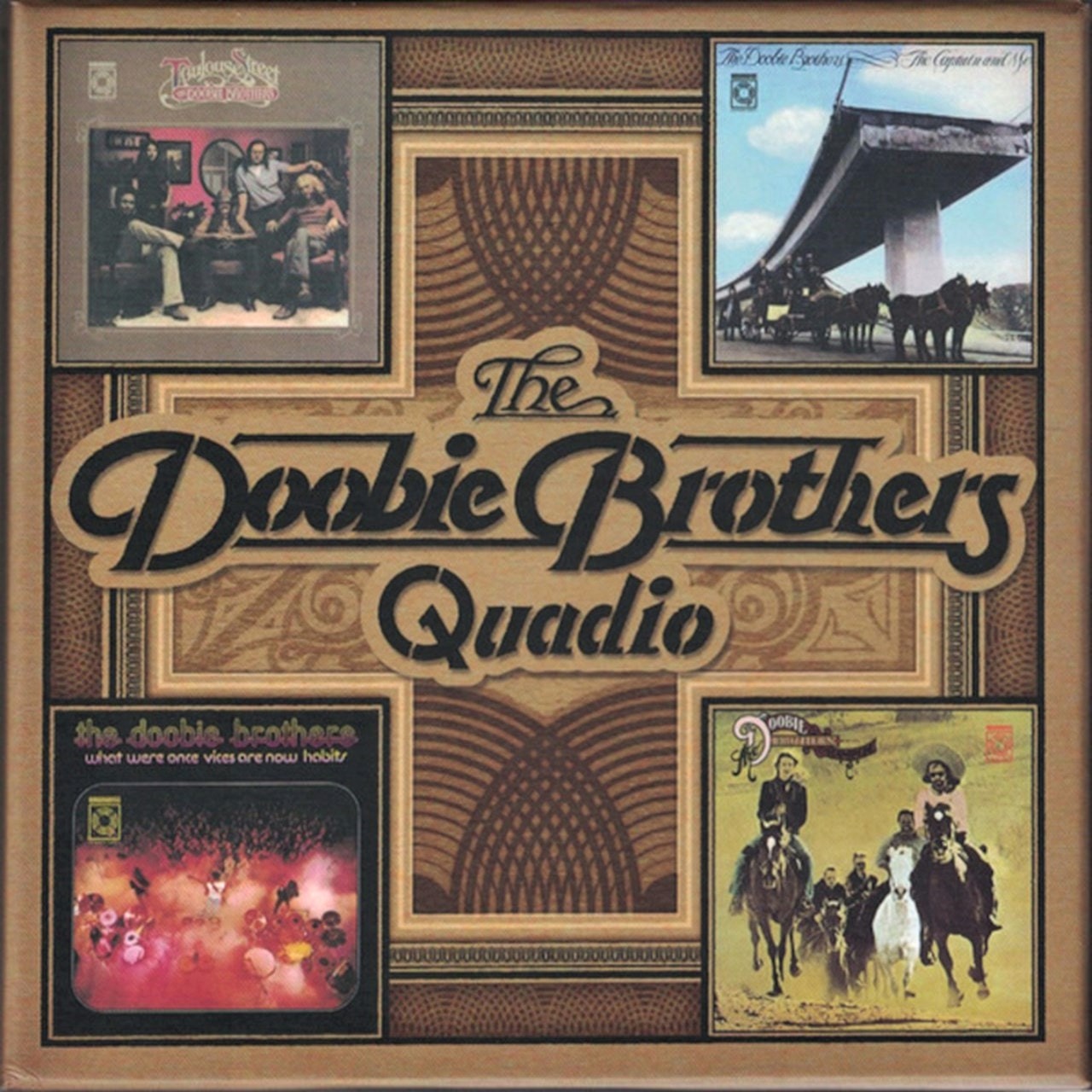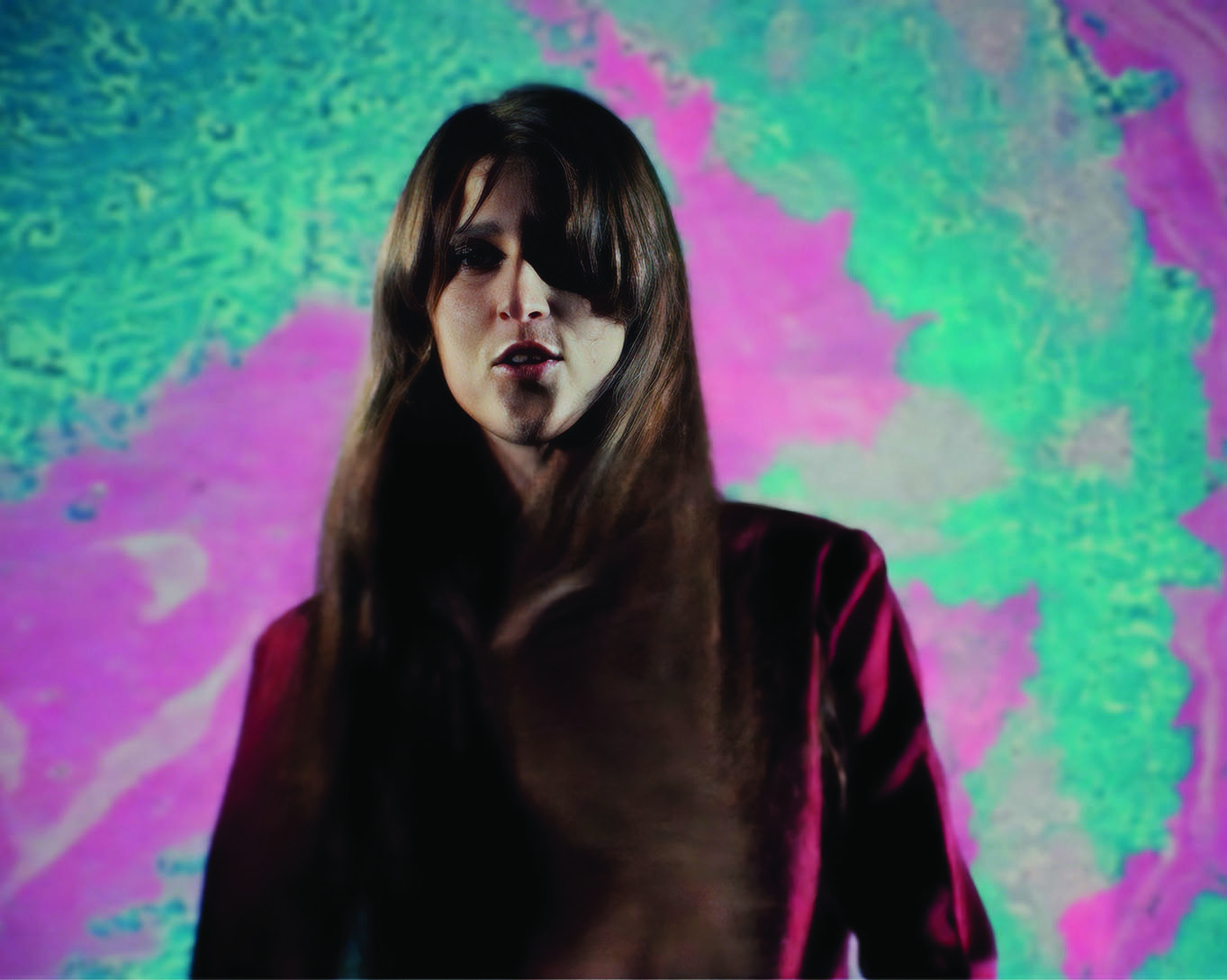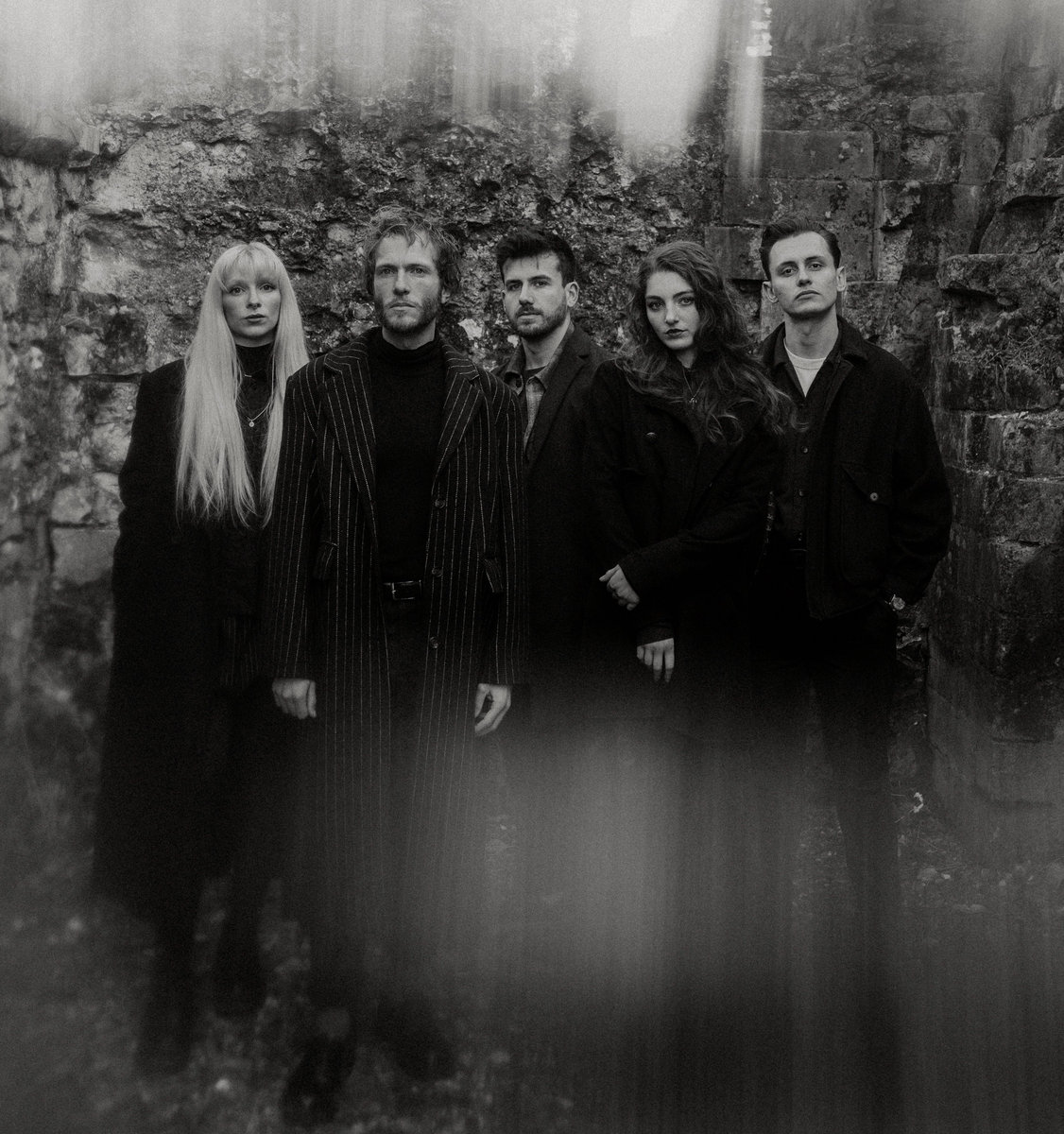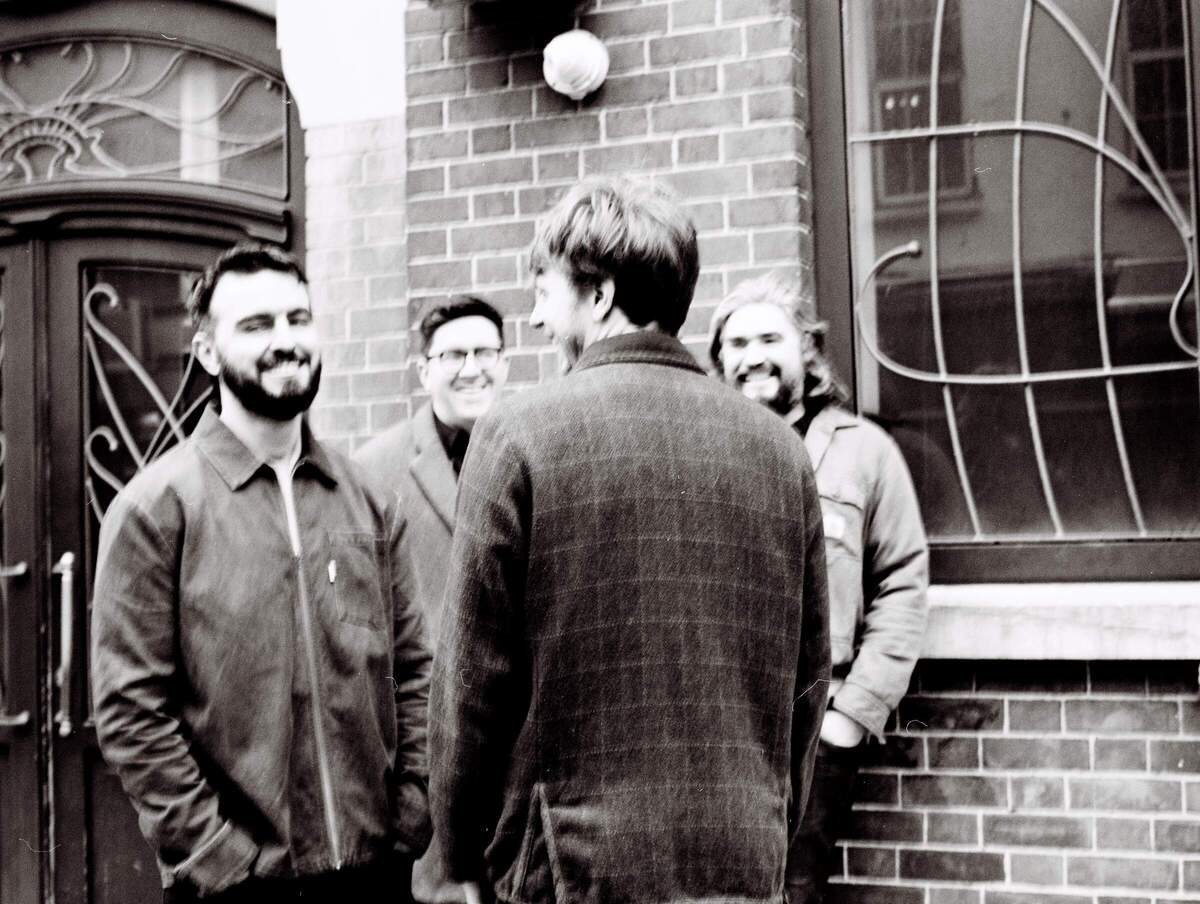The Doobie Brothers in Quadio
In the world of audio/video, it would seem everything old is not only new again, but in some cases maybe even better than it was before. One of the newest, yet oldest formats to emerge, or re-emerge, is Quad.
Quadrophonic sound was being developed as early as the 1950’s, but its heyday was during the 1970’s. Just as sophisticated and powerful home music systems began to become popular in the 1970’s to reproduce the multi-tracked popular rock music recordings that first took root with the Beatles’ ‘Sgt. Pepper’ in 1967 and reached a popular peak in 1973 with ‘Dark Side of the Moon’, Quad was launched in a big way. The new format required two extra speakers and usually a Quad stereo amp, with Sansui leading the way, and/or a relatively inexpensive decoder to reproduce one of the Quad formats. There were several Quad formats, but the primary one was SQ. Major record labels such as Columbia and EMI released many records in this format at affordable prices. The format died off quickly and within a few short years after the end of the vinyl album heyday or the 1970s, digital music in the form of compact discs became the new dominant format. Eventually, various Quad formats emerged during the digital age, but they were few and far between and primarily catered to hard-core audiophiles.
A recent twist on Quad that has come about is Quad music on Blu-ray. In 2016 Warner Brothers, through its Rhino reissue imprint, first issued the Chicago Quadio Box, a nine-disc Blu-Ray Audio set, which is now long out of print. Recently, the label issued the Doobie Brothers Quadio box, a four-disc set that includes the group’s second through fifth albums: ‘Toulouse Street’, ‘The Captain & Me’, ‘What Were Once Vices Are Now Habits’, and ‘Stampede’. The discs also include DTS-HD Mater Audio High-Resolution stereo mixes of each album. Each individual Blu-ray-disc album is a CD-sized package which faithfully reproduces the album design, including a replica poster inside the ‘What Were Once Vices Are Now Habits’ album. Technical information on the way these new discs work and additional original Quad technical notes are included. There’s no question that these are perfect albums for high-end audio treatment, particularly ‘The Captain and Me’, a defining album of the lush West-Coast studio sound. All of these albums were originally meticulously produced by Ted Templeman, who, after co-producing the group’s debut with Lenny Waronker, produced all of its Warner releases through 1980 and returned in 2010 to produce ‘World Gone Crazy’. Templeman also worked wonders for Doobies label-mates Little Feat and had big hits with the records he produced for Van Halen.

The Doobie Brothers went through a rapid evolution during the mid-70’s. After the group’s self-titled debut, which stayed true to its Northern California, biker-bar band roots, the group immediately blossomed on its second album, the aptly titled ‘Toulouse Street’. The album reflected many American roots musical sounds and established the group’s distinctive vocal harmony blend, guitar rock credentials and ability to write hooky songs. As stated previously, ‘The Captain and Me’ was a watershed 70’s album rock release and added an even finer production quality to the group’s sound, making for one of the best recorded albums in a decade filled with great sounding releases. The album also extended the family of musicians contributing beyond the core group of Tom Johnston and Patrick Simmons, with studio support by Bill Payne of Little Feat and Jeff “Skunk” Baxter of Steely Dan. On ‘What Were Once Vices are Now Habits’, the hits kept coming and the group succeeded in following up one of the best albums of the decade. Baxter would become a full-fledged member on ‘Stampede’, which supplied more hits, but which proved to be the end of an era. Tom Johnston would begin to experience substance abuse issues and, on the group’s next album, ‘Takin’ it to the Streets’, Michael McDonald began to be a major factor in the group and the group’s sound underwent the most dramatic change since the group’s second album.
Since Quad may be an unfamiliar format for some and mostly audio/video enthusiasts have a base knowledge of these kinds of discs and hardware, below is an interview with Mike Vieira of the Life in Surround YouTube channel. Vieira is an expert on A/V equipment and sound and in particular on Surround Sound.
While there is a large community of vinyl enthusiasts out there, Life in Surround is the destination for optical media aficionados. While some of the media Vieira reviews and discusses has visual content, he is most concerned with the various optical audio media formats and new releases and reissues of music in the various formats, including releases in the latest Dolby Atmos format, which is the most advanced optical audio format and seems to be gaining steam and interest beyond a niche audience. With lots of high-end optical disc packages coming out from groups such as Pink Floyd and the Beatles, among others, Vieira’s expertise is rare and invaluable. We spoke with him about the new Doobie Brothers Quadio box, the Quad format, other releases, tips on equipment and life in the rarified surround sound world.
Steve Matteo: I would like to start out with a little background on Quadio. Other than the Chicago box, which was released in 2016, have there been other Quad releases on CD, Blu-ray or vinyl that you are aware of, and if so, are there many, or any particular favorites and why.
Mike Vieira: Speaking purely of the Quadio series, there are: ‘Chicago Transit Authority’ DVD-V (DTS), ‘Best of Aretha Franklin’ DVD-V (DTS), ‘Chicago Quadio’ Box Blu-ray Audio, ‘The Doors The Singles’ Blu-ray Audio & ‘The Doobie Brothers Quadio’ Box Blu-ray Audio. Other labels, such as Audio Fidelity, Dutton-Vocalion and quite a few others have put out Quad mixes on several different platforms, including SACD and DVD-A. My “Great Quad Rescue” video might be a good starting point for further study. Plus, I did a Dutton-Vocalion video and quite a few videos about stand-alone Quad albums, like Santana.
SM: How do any of those releases stack up to the Chicago or Doobie Brothers boxes?
MV: Chicago and The Doobies Boxes represent the best value for optical (discs read with a laser) Quad releases that I can think of. There are those who take minor exception to the mastering employed on the two box sets. I’m not one of them. They sound fine to me. The Doobie Brothers Box contains all very strong albums, in my opinion, so its value is very high indeed. The Chicago Box is a bit harder for me to get through and I find myself listening to a few of the albums way more than the others. So, for me The Doobies set is the best, so far. Though the Chicago albums I love: ‘Chicago Transit Authority’, ‘II’, ‘V’ & ‘IX’ all crank!
SM: Other than the number of discs, how would you compare the Chicago and Doobie Brothers sets? What was the amount pressed of each box?
MV: Both boxes really opened my eyes to the titanic talent and musical prowess of both bands. Formerly, I was really only familiar with several radio hits. The Doobies set is more digestible for me. I find their music a little more “fun” than much of Chicago, so it gets my top personal vote. The same sort of care was taken for both sets though. If you love the Terry Kath Chicago years, Chicago Quadio is an absolute must and quite a great value. Even if you don’t love some of the albums it’s an exceptional value. I reached out to the producer of these Quadio sets, Steve Woolard, to get the numbers you’ve asked for. Chicago Quadio has seen two runs of 3000 and 1500, for 4500 total units shipped. The Doobie Brothers set has received only one run of 3000. There are no further runs planned for either set.
SM: Do you think the Doobie Brothers set will also go out of print?
MV: Well, I might not be in the best position to guess, but I think the Doobies set should go out of print. The price is more than fair and the set comprises four really awesome albums.
SM: What is the best way for people to listen to the Quad mix on the Doobie Brothers set? Specifically, most of the people who will buy the set, no doubt have at least a 5.1 Surround Sound system. What setting or settings should they use to listen to the quad mix?
MV: Ok. My answer should be taken with a grain of salt, as music appreciation is infinitely subjective, but… I made a video about this very topic!
In my experience, classic Quad mixes, from back in the 70’s, don’t always sound well-balanced on some 5.1 (or more channels) systems. One reason is speaker positioning, particularly of the surrounds and the other is the size of the speakers. I found it highly beneficial for enjoying classic Quad, to build a full-range Quad system. The basic reason is that classic Quad albums often have super important musical information, such as the entire drum kit in one channel, sometimes the rears. It doesn’t sound quite right for a satellite speaker to carry all that load, even if a subwoofer, somewhere in the room, is helping out. As far as other settings go, I run auto room calibration on my processor, and when it’s all set, I shut off ANY dynamic feature. Like dynamic EQ. I leave all the speaker volumes, delay distances as auto-calibrated though. I play all albums in “direct” mode, so I hear only what the engineer intended for each channel. This is most satisfying, for me.
SM: How about the stereo mix. How should they set their amplifier? How would you compare the stereo to the quad?
MV: The truth is I rarely check out stereo or mono mixes, unless a CD is provided, which I often listen to in my car. They’re just different animals, but the way I see it, listening to stereo familiarizes me with an album and listening in Surround Sound immerses me in it. It’s a deeper experience.
SM: What are the differences and pros and cons to Quad vs. 5.1?
MV: Mmmm, interesting. Ok, the advantage of 5.1 (or 5.0, for that matter) is that the center channel can be utilized for important music content that is usually panned to “phantom center” in stereo mixes. E.g. lead vocal, bass guitar, kick drum and snare drum. This can take load off of the front left and right speakers, allowing them to do the remaining work for the front of the mix more efficiently. Bob Clearmountain mixes this way and I love it. Steven Wilson is famous for nearly isolating the lead vocal and sometimes lead instruments in the center channel. The danger here is that listeners often have their center speaker in a bit of a funky spot, like super high or super low, which can make the lead parts sound detached from the album. Some systems treat the center speaker as a bit of an afterthought too. Smaller, under-powered, etc. If a nice center speaker, with plenty of power is positioned and calibrated correctly, there shouldn’t be any detachment or weirdness, assuming the mixing engineer created a good mix. Now, with Quad, you take all those hazards out of the equation. Phantom center works great, as evidenced by umpteen killer stereo mixes over the years. So, I’d have to give the nudge to Quad, for being potentially less troublesome and more enjoyable than 5.1. Regarding the .1 of surround mixes… LFE simply isn’t necessary for music. And LFE, when delayed by certain processes, phase inverted, mixed with full-range frequencies and such can do more harm than good. If your system is full-range or employs proper bass-management, there is simply no need for LFE. Not that I can wrap my mind around, anyway.
SM: The music industry and record companies would seem on the surface to be willing to let CD’s or physical media in general, other than vinyl, become obsolete, but the labels still press CD’s and also DVD’s and Blu-rays in various audio configurations, so there is obviously still sales potential, or they wouldn’t do it. Will there be a point where CD’s, DVD’s and Blu-rays become obsolete, only have a niche audience of hobbyists/enthusiasts or will any of these formats, particularly CD’s have a revival like vinyl?
MV: I think optical formats might already be at the niche stage. People like to own objects. The tactile feel of a box set. That experience won’t ever be entirely replaced by any digital download. So, I don’t think optical will ever truly die. Though one of my favorite formats, DVD-A is pretty much dead. Dolby Surround CD and DTS CD are dead. SACD, DVD-V and Blu-ray (V & A) are all doing fairly well. There may come a time, when those of us who enjoy the physical album experience are all gone, but I think the love of it might be handed down to enough youngins that optical might survive indefinitely. At least used albums, if pressing them dies.
SM: Could you list your audio/video components?
MV: My 5.1/7.1/Atmos/Auro-3D system is a Denon x6400H. Fed by a Sony X800 universal Blu-ray player. The speakers are mostly various sizes of Definitive Technology Promonitors. 1000’s for the fronts, 800’s for the surrounds and 600’s for the rears and heights. My center is a giant 4-woofer Polk beast. Perfect for those Bob Clearmountain and Steven Wilson mixes. My dual subs are 12″ Polk’s. 7.2.4 total. I plan to take some load off the Denon soon by introducing a separate Emotiva A-700 7 channel amp, to power the “ground” mix, leaving the Denon to handle the heights only. My full-range, listening system is comprised of an Emotiva UMC-200 5.1 processor, chiefly powered by an Emotica A-800 A/B amp, bridged to form a fairly powerful and clear Quad amp. For occasional 5.1 listening on this system, I use an old Crown D150A, bridged into a monoblock and modded for electrical grounding. The speaks are all vintage 1992 Klipsch KG series. The center is the KG series 2-woofer, 1 tweeter kind, while the fronts are KG 5.5’s and the rears are KG 5.2’s. So, the Quad channels are all full-range. The seller of the 5.5’s threw in the vintage, massive subwoofer for almost nothing. It doesn’t get much work, but it’s nice that it’s there, especially for the occasional 5.1 album. It’s all fed by my OPPO BDP-103, via HDMI, since the 103 DAC isn’t that great. I’d love to get my hands on a 205, in which case I’d likely go analog. I’m very, very happy with the listening station.
SM: If you were to recommend a basic 5.1 set up (amp, Blu-ray player, speakers), what would you suggest?
MV: I did a video on this!
I almost always buy used, clearance and/or refurbished, so my money goes further. I recently bought my vintage Klipsch speakers for around the same cost as Best Buy current Klipsch speakers, but I love the vintage sound FAR more. In my opinion, everything new in my price range sounded terrible and in no way encouraged me to part with my cash. I had to hunt and wait for vintage equipment to pop up in my area, but really only a few months and it was so worth it! For Blu-ray players, you want universal. I’m aware that there are several brands available, but my experience mainly lies with OPPO. They aren’t manufacturing anymore and prices for used units are rising! I’m pretty happy with my Sony X800. I even bought a back-up unit, still boxed, when they were still super-cheap. Like $120. They’re more expensive now, but still a good value. Be warned though that for true 4.0 mixes (no silent center and/or LFE for compatibility) the X800’s drop the rear channels! So you only hear 1/2 of the mix!
SM: Can you list a few of your favorite surround discs/sets, what is the format(s) and why are they tops for you?
MV: Ok, I did a video on this! But I’ll try this one off the top of my head, so you know these albums/mixes really mean something to me.
1. Rush – ‘A Farewell to Kings’ – Steven Wilson 5.1 Blu-ray Audio mix, found only in the 40th Anniversary set. Insanely active, yet tasteful mix. Neil Peart’s drums wrapping all around you. Accept no substitutes, especially not the earlier Chycki mix…
2. Pink Floyd – ‘Dark Side of the Moon’ – original Alan Parsons Quad Blu-ray Audio mix, found only in the Immersion Set. It smokes Guthrie’s 5.1 mix.
3. Queen – ‘A Night at the Opera’ – Elliot Scheiner/Brian May 5.1 mix. The two DVD-A versions are great, but the Blu-ray sounds a bit better, to me. Scheiner is like the Godfather of 5.1 mixing. Steven Wilson caught the bug from him.
4. Santana – ‘Abraxas’ – classic Quad mix. Avoid the dingy, ill-balanced DTS CD and go for the recent Sony Japan 7″ series Quad SACD.
5. Roxy Music – ‘Avalon’ – Bob Clearmountain 5.1 SACD mix. Bob Clearmountain is a mixing genius. Infallible ears. Analog mixing desk!
6. The Pineapple Thief – ‘Where We Stood’ – Bruce Soord 5.1 Blu-ray Audio and Video mixes. A concert aggressively mixed in surround, plus an album or two and an EP, all in surround. Available for the cost of a single album. Great music, great mixing, great value.
All lossless formats: SACD, DVD-A or Blu-ray Audio/Video are tops for me. There are amazing examples of each. There are clunkers in every format too. Depends on the performance, record, mix, mastering and sometimes authoring too! There are also wonderful lossy releases too. I just wish the industry would stick with modern technology, rather than 90’s technology (as a cost-saving measure, best I can tell).
SM: Anything that hasn’t been released in surround, and/or in particular formats you would like to see?
MV: So many albums I’d like to see mixed in surround. ‘Master of Puppets’ from Metallica, ‘Rust in Peace’ from Megadeath, ‘The Number of the Beast’ from Iron Maiden, ‘Astral Weeks’ from Van Morrison, ‘Revolver’ from the Beatles and ‘Don’t Shoot Me I’m Only the Piano Player’ from Elton John. So many more albums, so many more artists. We get what we get with this hobby! If every album ever were mixed in Surround, it wouldn’t be special. Still, it’s frustrating when the only album from a favorite band is far from their best. Like Iron Maiden ‘Dance of Death’…
SM: Is there anything else you would like to add?
MV: In addition to Quad and 5.1, I also enjoy the occasional 7.1 mix, like Pat Metheny’s ‘Orchestrion Project’, Atmos albums, like ‘Catalog’, by Kraftwerk and Auro-3D albums, like ‘2L’s Mass for Modern Man’. There are some good albums to be found as download only, or even streaming only. Shiny discs will always be my true love though.
Steve Matteo
The Doobie Brothers: ‘Quadio Boxed Set’ (Rhino, 2020)



